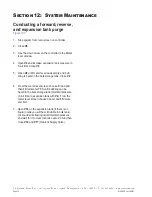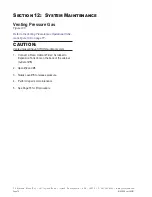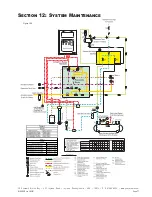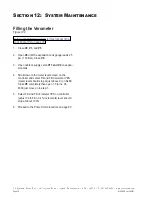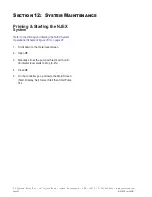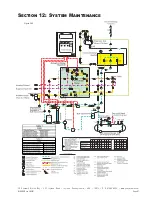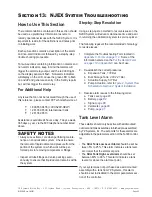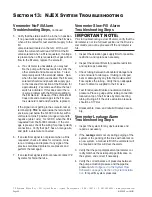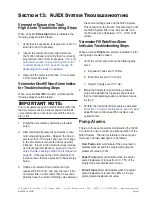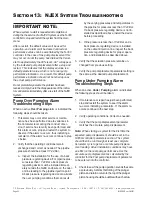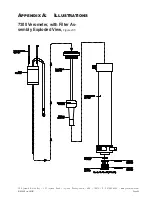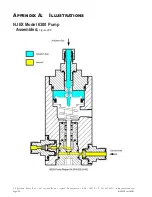
YZ Systems Milton Roy • 201 Ivyland Road • Ivyland, Pennsylvania • USA • 18974 • P: 281.362.6500 • www.yzsystems.com
Page 88
NJEX EUR ver. 08-2021
Section 13: NJEX System Troubleshooting
Verometer No-Fill Alarm
Troubleshooting Steps,
Continued
5. Verify that the status switch be in the run position.
If no pneumatic supply is received at the fill valve
when a fill is called for, test electrical supply to the
fill
valve solenoid located on the left. With a volt
meter the current should read 12VDC at the fill
valve solenoid when a fill is requested. If voltage
is present when a fill is requested, but gas will not
flow to the fill valve, replace the solenoid.
a. If a volt meter is unavailable, you may test
fire the pump with the test switch to verify the
other solenoid and cable are active. To test,
temporarily switch the solenoid cables. Now
when the test switch is activated, the fill valve
solenoid should send pneumatic supply gas
to the loosened connection at the fill valve for
approximately .2 seconds each time the test
switch is activated. If this does occur there
is some problem with the fill signal getting to
the fill solenoid. However, if the solenoid still
does not send actuation gas to the fill valve
the solenoid is bad and should be replaced.
If the signal is not getting to the solenoid, test at
terminal strip
TB2
, located inside the termination
enclosure just below the N-300 Controller, with a
volt meter at pins
7
positive
(orange wire)
and
8
negative
(violet wire
), for 12VDC when the fill is
requested from the N-300 controller. If the volt-
age is present, check the wiring for proper polarity
connections. Verify that pin
7
has an orange wire,
and pin
8
a violet wire connected.
6. If an electrical signal is not present when a fill is
requested, check all cables for corrosion, mois-
ture, or damage and replace if any signs of the
previous mentioned problems are present and
perform the test again.
7. If an electrical signal is still not present contact YZ
Systems Technical Service.
Verometer Slow-Fill Alarm
Troubleshooting Steps
IMPORTANT NOTE:
Prior to troubleshooting a slow fill alarm, verify that the
Verometer is not in a full level position as the fill valve
commands can not be processed if the Verometer is
full.
1. Inspect the actuation gas supply filter for possible
restriction, and replace as necessary.
2. Inspect the odorant filters for possible restriction
and replace as necessary.
3. Check tubing between bulk odorant storage tank
and enclosure for damage. If tubing is crimped,
bent or damaged by any form that could restrict
flow, replace the tubing. Verify that an adequate
flow of odorant is supplied to the fill valve.
4. Test for adequate fill valve pneumatic actuation
pressure. Place a guage at the tubing connection
located on top of the fill valve by disconnecting
tubing. During a fill, the valve actuation pressure
should be
5.17 Bar
.
5. Disassemble, clean, and rebuild fill valve assem-
bly.
Verometer Leakage Alarm
Troubleshooting Steps
1. Inspect the system for any obvious leaks and
repair as necessary.
2. If the
Leakage
alarm occurs during purging of the
system or the packing of the lines with odorant on
a new system, a manual refill of the verometer will
be required and this will clear the alarm.
3. Verify that the pump displacement parameter cor-
rectly matches the actual pump performance on
the system, and correct if necessary.
4. Verify the correct balance of pressures between
the pump actuation pressure and the pipeline
refer to figure 4, in the System Flow
Schematic on page 6, Section 2: System Installa-
for specific system pressures.
Summary of Contents for NJEX 6300G
Page 1: ...NJEX 6300G 7300G N A T U R A L G A S O D O R I Z A T I O N S Y S T E M...
Page 2: ......
Page 3: ...NJEX 6300G 7300G Instruction Operating Manual Version 08 2021...
Page 4: ......
Page 10: ......

